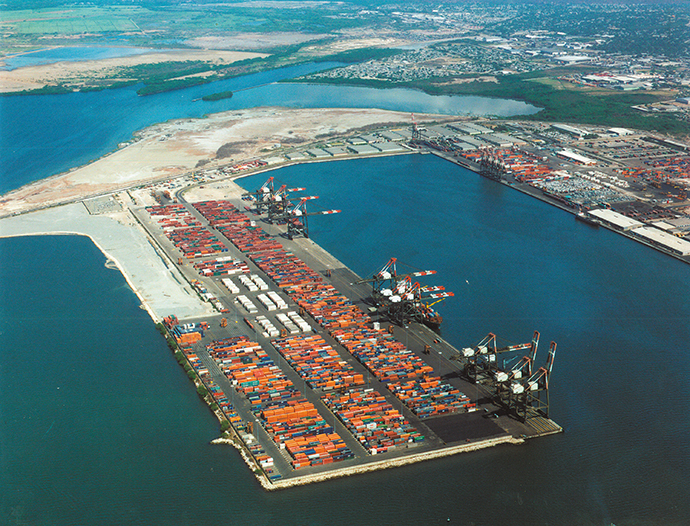The Government of Jamaica has unveiled ambitious plans that will build the Caribbean into a Global Logistics Hub for the Americas and position it as a regional trading mecca similar to Singapore, Dubai and Rotterdam. High level discussions have already started with a number of overseas investors to develop vast areas of prime real estate to handle increased volumes of air and sea cargo. Projects under discussion include growth of container throughput at the Port of Kingston ahead of the expansion of the Panama Canal, as well as the development of commodity ports to handle petroleum products, coal, minerals and grain; the development of an air cargo stronghold through the construction of an air cargo airport as well as the construction of large scale ship repair dry docks. Special economic zones are also being conceptualized by a wide range of local and foreign investors.
Once completed, the initiative, which is being spearheaded by the Jamaica Ministry of Industry, Investment and Commerce, will transform Jamaica into the fourth node or pillar in the global supply and logistics chain alongside Singapore, Dubai and Rotterdam. A critical element in the equation to make the Logistics Hub successful is the involvement of suitable, long-term investors. The Government of Jamaica is already in discussion with prospective partners and is looking for new ones.
Sustainability Centerpiece
Hon. Anthony Hylton, Minister of Industry, Investment and Commerce, said the vast project contained many opportunities for investors, logistics providers, distributors, manufacturers and suppliers across many industries around the world. He noted that the initiative will provide a myriad of opportunities for global and domestic commercial and industry interests.

The Hon. G. Anthony Hylton, Minister of Industry, Investment and Commerce, who has been spearheading the Jamaica logistics project.
The development of Jamaica’s transportation – maritime, aviation, road and rail and logistics infrastructure – will enable the country to be positioned as the logistics hub of the Americas (North and South America). This effort, he said, represents the centerpiece of a sustainable economic growth strategy.
The Minister explained, “I recently returned with a delegation from Asia as part of advancing the logistics hub initiative, and I must tell you that the results of my trip are very reaffirming and instructive. The results reaffirmed the soundness of the logistics hub initiative and further clarified the opportunity and the tasks that are before us.”
A market of 800 million persons, including the US and Brazil, can be accessed readily from Jamaica. Trade opportunities will soon skyrocket with the expansion of the Panama Canal scheduled to be completed in 2015, a massive government stimulus package by Brazil for World Cup 2014 and Olympics 2016 and the growing middle class in Latin America.
A critical aspect of the global logistics hub initiative is the broadening of bilateral collaborations with Jamaica’s global partners, and encouraging private-sector investment and financing through private-public partnerships (PPPs).
Big Plans for a Special Economic Zone
Several cornerstone projects have already been proposed, including the development of the Caymanas Special Economic Zone (CEZ) which will represent a significant advancement of Jamaica’s industrial infrastructure. CEZ is part of a broader urban development plan called the Caymanas Estate Development Plan. The Urban Development Corporation (UDC) and the Factories Corporation of Jamaica (FCJ) will simultaneously develop 10,000 acres (4,050 hectares) of the Caymanas estate for various purposes such as recreational, residential, and commercial usage.
Of the 10,000 acres for land development, requests for proposals are being solicited by the FCJ for the development of the first phase of the Caymanas Special Economic Zone that would provide complete infrastructure for approximately 200 acres (81 hectares).
The CEZ will focus on the key sectors of distribution, manufacturing, agro-processing and creative industries. Plans for the CEZ include housing a research institute, a small business incubation center, light manufacturing facilities, logistical planning & warehousing, pharmaceutical, assembly plants, software development, telecommunications and information technology business, hotels and an aerodrome (existing).
The CEZ would link the business districts of Kingston and Spanish Town. The zone would have major road networks, including the island’s major Highway 2000, feeding into it from various entry points. It would be located near the Port of Kingston, which is located less than 10 minutes away and the Norman Manley International Airport; thereby facilitating the transport and logistics service needs that would be generated by the activities within the CEZ. Finally, the zone would be located near the town of Portmore, which has a relative high density of educated, skilled Jamaican workers from which the zone would be able to draw its labor force.
The commodity port to be built in eastern Jamaica, will provide crude oil and petroleum product tankage, together with blending, natural deep water loading, discharging and transshipment capabilities could guarantee uninterrupted supplies of crude oil, gas and refined products to global markets. Other terminals will cater to bulk minerals, grain and other commodities.
Other key strategic priority areas within the Hub’s development include expansion of the Kingston Container Terminal and airports, logistics planning and warehousing, strategic storage of manufactured merchandise and bulk commodities, ship repair/dry docking and aircraft maintenance, repair and overhaul.
A substantial economic stimulus will be created from the construction activities related to the logistics hub. This will be a precursor to major manufacturing and distribution companies establishing offices and/or warehousing facilities as well as a plethora of logistics companies transacting trade-related deals globally for goods and services that are either manufactured in Jamaica or elsewhere.
The Hub will cater for goods assembled in Jamaica or elsewhere, transiting through Jamaican ports or not, warehoused in Jamaica or elsewhere; E-commerce; value-added logistics, import/export-related activity; financial activities; free zone activity; cargo hub activity; mail hub activity; passenger hub activity; intermodal transfers of passengers, education and training; cargo security activities; intermodal transport and the transshipment of goods.
The environment for logistics activities is created primarily by providing a business and social environment that attracts the firms that engage in the above-mentioned activities. It is necessary to have a work force, imported or indigenous, that can fill the jobs related to the many economic activities that take place in a logistics-dominant environment. Without a doubt, there will be investment in Jamaica’s most important asset, its human resources, through education and training. Other priorities include infrastructure, social development and enabling legislation as the Government sets the stage for its new role as a global logistics hub.
